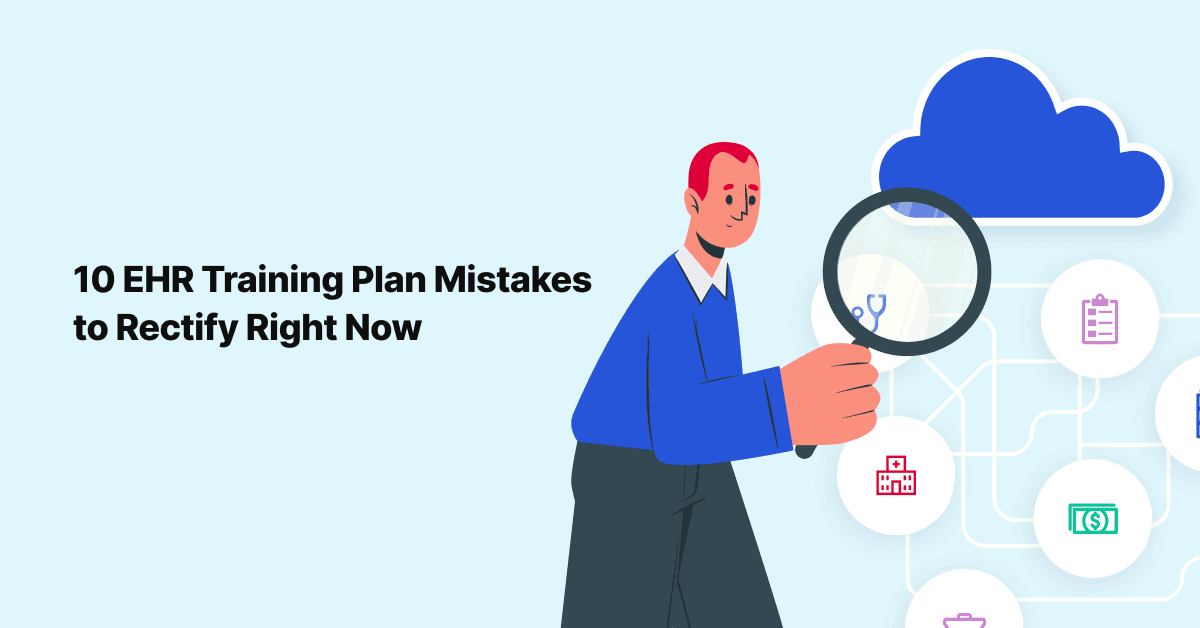If your EHR training plan has stood the test of time, it's time for a check-up.
Let's scrutinize its performance, spot any hiccups, and fine-tune it for peak efficiency. Join us as we uncover ten common mistakes that may have slipped into your EHR training and explore actionable solutions.
1. Neglecting a Thorough Needs Assessment
Imagine trying to bake a cake without knowing what flavor your friends like. That's what happens when you forget to find out what your healthcare staff really needs before diving into EHR training. It's like throwing ingredients into the bowl and hoping for the best, but you might end up with a cake that nobody wants to eat.
How to rectify it?
- Schedule one-on-one interviews with key stakeholders to gather insights into their daily workflows and pain points.
- Utilize surveys to collect anonymous feedback on the current state of EHR proficiency.
- Observe staff in their work environment to identify specific areas where the EHR system may not align with their needs.
2. Falling for the One-size-fits-all Trap
Picture this: You walk into a shoe store, and there's only one shoe size available. It doesn't matter if you have big feet or tiny ones – everyone gets the same shoe. Sounds ridiculous, right? Well, that's what happens when you fall into the one-size-fits-all trap with your EHR training. Chaos ensues, frustration builds, and suddenly, your workplace feels like a mismatched circus act.
But fear not! The solution is simpler than finding the right-sized shoe.
How to rectify it?
- Create role-specific training modules that focus on the functionalities most relevant to each job function. For example, surgeons may need training on post-operative medication administration orders, while administrative front desk staff may require guidance on scheduling.
- Incorporate case studies or scenarios that mirror the day-to-day challenges of each role.
Effective EHR training isn’t just about avoiding a one-size-fits-all approach—it’s about ensuring your team gets the right guidance tailored to their needs. For a deeper dive into how to approach Epic software training strategically, check out How to Approach Epic Software Training and Succeed.
3. Skimping on Training Resources
Skimping on resources is like finding yourself stranded in a learning desert. It's attempting to build a sandcastle with one bucket of sand or cook a gourmet meal with only salt in your pantry. The result? A barren landscape leaves your staff thirsty for the knowledge they need.
But fear not! The remedy is not just a drop in the bucket – it's a cascade of learning opportunities.
How to rectify it?
- Develop a comprehensive training toolkit that includes a variety of resources.
- Create microlearning video tutorials that can be accessed at any time for self-paced learning.
- Establish a dedicated online platform or knowledge base where users can find FAQs, troubleshooting tip sheets, and additional support materials. Let’s make that easy for you; a tool like Jeeves does that for you.
4. Forgetting Workflow Integration
Neglecting to integrate EHR training seamlessly into your existing workflows is akin to trying to solve a puzzle with missing pieces. It results in a disjointed workflow where the EHR system feels like an awkward addition rather than a smooth part of the daily routine. This lack of integration leads to confusion and inefficiency, much like having a GPS that knows the destination but struggles to understand the journey.
How to rectify it?
- Collaborate with representatives from different departments to create workflow maps that highlight touchpoints with the EHR system.
- Identify natural integration points for training, such as incorporating EHR tasks into existing training programs.
- Provide job aids or quick-reference guides that users can consult within their workflow.
5. Overlooking User Involvement
Neglecting to involve healthcare professionals in the planning and decision-making processes of your EHR training plan is a significant mistake. It creates a disconnect between the training provided and the actual needs and expectations of users, leading to dissatisfaction and resistance.
When users are not actively involved, the EHR training plan may miss the mark, leaving users feeling unheard and disengaged. It's essential to rectify this mistake by actively involving users in the development and decision-making stages.
How to rectify it?
- Form user groups representing diverse roles within the organization. Schedule regular meetings to discuss challenges, share success stories, and provide feedback on the EHR system and training materials.
- Involve users in the decision-making process for future system updates or enhancements.
- Consider creating a user forum or online community where staff can ask questions and share tips.
6. Ignoring Ongoing Training and Support
Neglecting ongoing training support in your EHR training plan is akin to providing a roadmap without any road signs. It leaves users navigating the complexities of the system without guidance, resulting in frustration, inefficiency, and potential errors.
Why It Matters?
- Knowledge Retention: Without ongoing training and support, knowledge acquired during initial training can fade. Continuous refresher courses act as reinforcements, preventing the erosion of essential skills over time.
- Adaptation to Updates: In the dynamic landscape of healthcare technology, systems, especially EHRs, are subject to updates and enhancements. Ignoring ongoing training and support leaves users struggling to adapt to changes, potentially leading to errors and inefficiencies.
- Addressing Emerging Challenges: Healthcare is dynamic, with new challenges arising regularly. Regular check-ins and feedback sessions provide a platform to address emerging issues promptly, ensuring that user concerns are heard and resolved.
- User Engagement: Ongoing training and support fosters a sense of community and engagement. User forums and peer support networks create a collaborative environment where healthcare professionals can share experiences, tips, and solutions.
How to rectify it?
- Have a tool like Jeeves that helps you easily create and share periodic refreshers in microlearning videos and tip sheets to reinforce key concepts and introduce new features.
- Conduct regular check-ins with staff to address any emerging challenges or concerns.
- Encourage the formation of peer support networks where experienced users can assist their colleagues.
7. Skipping Testing and Evaluation
When training lacks proper evaluation, it's like sending drivers onto the road without checking if they know how to handle various scenarios. This lack of assessment can lead to a range of problems, including:
- Inefficient Workflows: Without regular assessments, there's a risk that users may develop inefficient workflows or overlook key functionalities. This can result in time-consuming processes, hindering the overall efficiency of healthcare delivery.
- Decreased Proficiency: Users may struggle to reach optimal proficiency in using the EHR system, leading to errors, frustrations, and reduced confidence. This, in turn, can impact patient care quality and the overall effectiveness of healthcare processes.
- Resistance to Change: In the absence of evaluation, staff might resist adopting new practices or utilizing advanced features of the EHR system. This resistance hampers the transition to a more streamlined and technologically advanced healthcare environment.
- Missed Opportunities for Improvement: Skipping evaluation means missing valuable insights into what works well and what needs enhancement. This lack of feedback prevents the identification of areas that require attention, hindering the continuous improvement of the training program.
How to rectify it?
- Conduct regular proficiency assessments to evaluate staff competency in using the EHR system.
Implement knowledge checks that replicate common scenarios to test application skills. - Gather feedback through surveys or focus groups after each training session and use the insights to make real-time adjustments.
- Monitor key performance indicators related to EHR usage and identify patterns that may indicate areas for improvement.
Looking to evaluate your entire EHR training plan? Use this free template.
8. Poor Communication Strategies
Not having a strong communication strategy for your EHR System can be a grave mistake. It's like having a conversation in a noisy room where the important messages get lost in the chatter. Without a clear and effective communication plan, the benefits of the EHR system and its alignment with organizational goals may remain obscured.
How to rectify it?
- Create a communication calendar outlining key messages and milestones throughout the EHR implementation process.
- Use multiple communication channels, including email, intranet announcements, and physical bulletin boards, to reach different audiences.
- Highlight success stories and positive outcomes resulting from EHR usage to reinforce the benefits.
- Establish a designated communication liaison or ambassador within each department to facilitate open lines of communication.
9. Underestimating Change Management
Underestimating the importance of change management is a critical mistake that can lead to a reservoir of resistance within your organization. It's akin to expecting a river to flow smoothly without considering the rocks and obstacles in its path. Without a robust change management strategy, concerns may fester, and the transition to the EHR system may encounter unnecessary turbulence.
How to rectify it?
- Conduct change management workshops or seminars to educate staff on the reasons behind the EHR implementation and the long-term benefits.
- Establish a feedback mechanism to address concerns and misconceptions.
- Provide ongoing communication about the progress of the EHR implementation, acknowledging challenges and celebrating milestones.
- Offer incentives or recognition for staff who actively contribute to a positive change culture.
10. Ignoring Regulatory Compliance
Ignoring regulatory compliance is like neglecting to build a fence around a precious garden, leaving it vulnerable to external threats. It jeopardizes patient information security and legal integrity, posing significant risks to both the organization and its stakeholders. Failing to explicitly address regulatory requirements in the training plan can lead to unintentional violations and legal consequences.
How to rectify it?
- Collaborate with your organization's compliance and legal teams to create training modules specifically focused on regulatory requirements.
- Develop documentation and training materials that emphasize the importance of data privacy and security that are released monthly or quarterly.
- Conduct regular compliance audits and use the findings to inform ongoing training initiatives.
- Provide resources for staff to stay informed about any updates or changes in regulatory requirements.
In conclusion, by acknowledging these common pitfalls and implementing these practical corrections, your existing EHR training plan can undergo a positive transformation. Remember, ongoing improvement is a key component of successful EHR implementation. Adaptability, user engagement, and a commitment to addressing user needs will contribute to a more seamless and effective training program.




